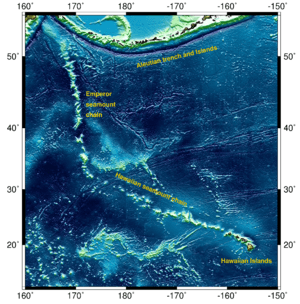Kōkō Seamount facts for kids
Kōkō Seamount (光孝海山) is a huge underwater mountain, also known as a seamount. It's actually an extinct volcano that lies deep beneath the Pacific Ocean. Kōkō Seamount is part of a very long line of underwater mountains called the Hawaiian–Emperor seamount chain.
Contents
What is a Seamount?
A seamount is basically a mountain that rises from the ocean floor but does not reach the water's surface. Most seamounts are volcanoes that are no longer active. They are often shaped like cones, just like mountains on land.
Kōkō: A Flat-Topped Seamount
Kōkō Seamount is special because it has a flat top. Because of this, it's also known as the "Kōkō Guyot." A guyot (pronounced "GHEE-oh") is a seamount with a flat top, almost like a table. This flat top was formed when the volcano was active and its peak was above the ocean surface. Waves then eroded the top, making it flat. As the Earth's crust moved, the seamount slowly sank back into the ocean.
Where is Kōkō Seamount Located?
Kōkō Seamount is found in the northern part of the Pacific Ocean. It's part of the Emperor Seamount Chain, which stretches for thousands of miles. This chain is made up of many underwater mountains, all formed by volcanic activity over millions of years.
The Age of Kōkō Seamount
Kōkō Seamount is a very old volcano. Scientists have studied its rocks to find out when it was formed and when it last erupted. The last time Kōkō Seamount erupted was about 48 million years ago. That's a very long time!
How Old are its Parts?
Different parts of Kōkō Seamount formed at slightly different times. The northern side of this underwater mountain is at least 52.6 million years old. The southern side is a bit younger, dating back to about 50.4 million years ago. This shows how these massive underwater structures grow over millions of years.
Who was Emperor Kōkō?
This amazing underwater mountain is named after Emperor Kōkō of Japan. He was an emperor who ruled Japan in the 9th century. Many features in the Hawaiian–Emperor seamount chain are named after emperors of Japan, honoring their history.
Related pages


